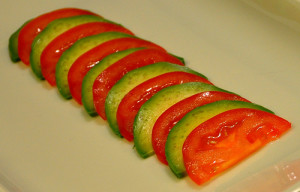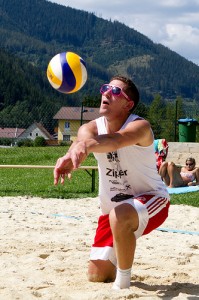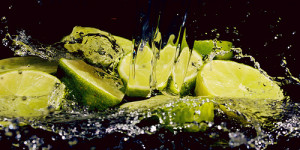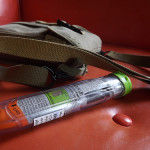by Michelle Sutton-Kerchner
Summer is filled with perks. Sometimes, we forget little annoyances that can interfere. Don’t let them rain on your fireworks …
Whether spending time in your backyard or enjoying the outdoors elsewhere, planning makes the difference. Sunny weather and clear skies have us heading outside like a line of ants marching toward their next crumb. With a few precautions, and a little knowledge, your disposition can match the weather– all day long (even with Granny, Little Joe, and Fido in tow ).
Plan a Healthy, Safe BBQ
The fun doesn’t have to be in the fat! Enjoy backyard fare while staying true to your healthy diet. Ditch the bun and build a non-burger on kabobs. Skewers are available in wood, or thin metal to go green. Load them with your favorites and get nutrition your way. Add seasonal veggies and fruits, with your choice of protein. Chicken and shrimp work well. You even can splurge guilt-free and use beef with these bite-size nibbles.

Avocado is a cookout’s nutritious alternative. Slice it to add moisture to burgers, dice it with onions and tomatoes for a dip, or use it in guacamole form as a spread on everything from crackers to corn on the cob. It is a healthy way to add flavor without sodium, sugar, and cholesterol. Research shows adding avocado to your burger may counteract some of red meat’s inflammatory-producing compounds, a heart-disease risk.
Follow safety guidelines to avoid food poisoning. Symptoms of food poisoning can be severe. However, mild cases may present themselves as a random stomachache or cramps. The connection may never be made. Be sure you and your guests don’t fall victim to the dangerous cookout combination of warm weather and buffet foods.
Food should not be kept at room temperature for more than two hours, according to Foodsafety.gov. If it is hotter than room temperature, such as baking in the 90-degree sun, the safety timeframe is considerably reduced. Despite warm weather, hot foods must be kept consistently hot with a burner or other heat source. If you are a late-arriving guest, consider that food may have been sitting out since before the festivities began. You may wish to grab a bite before arrival. Stick to nonperishable choices or the host’s second round on the grill.
If you are the grill master, be sure all raw meat is kept separate from other food. Wash hands after handling raw meat, and all surfaces that came in contact with this high source of bacteria. Use hot, soapy water. Cook beef to 160 degrees, poultry to 165 degrees, and steaks to 145 degrees with a three-minute rest time. Color and texture are not indicators of doneness. Use a meat thermometer.
Common-sense reminder: Keep the grill several feet away from the house and out of high-traffic areas. Insurance adjusters can attest to melting house siding from a grill’s heat. And, we all know kids and pets can get underfoot, as can the occasional guest who enjoyed one too many cold ones!
Practice Sun Smarts
After the short, bitter days of winter, we are ready to soak in the sun. The body and mind crave its bright warmth. Our bones soak up the vitamin D. Indulge but not before you arm yourself with sunblock, sunglasses, and plenty of water.
Your skin is the force that stands between you and an often environmentally harsh world. Protect it well with appropriate levels of sunscreen. Reapply screen often, regardless of its promise to be water resistant. The first application should be applied about 30 minutes prior to going outdoors.
Do not be fooled by the new release of sun protection touting an SPF of 70+. Consider this a gimmick to lure the palest worriers among us to rush for new bottles of the high-priced stuff. A higher SPF does not equate to significantly stronger protection against the sun. The numbers simply refer to the duration of protection.
The FDA would prefer a cap of SPF30. Numbers above 30 provide little increase in protection and a false sense of security. Users misinterpret their protection factor, which puts them at risk for sunburn. An SPF 15 blocks approximately 93 percent of the sun’s rays compared to an SPF 30, which blocks about 97 percent. Protection is not twice as strong but rather may last twice as long.

Try to schedule fitness excursions for a shady time of day. Sun is strongest between 10 a.m. and 4 p.m. Research has proven a connection between sweating in the sun and skin cancer. Sweating may increase photosensitivity of the skin, which makes it more prone to sunburn and UV-associated damage. This type of exposure increases your risk of skin cancer.
Don’t forget to apply sunscreen during cloudy days, when sightseeing, or simply enjoying an outdoor cafe. Harmful UV rays can do their damage in as little as 10 minutes, and penetrate cloud cover. You don’t need a beach or pool scene, with a cloudless sky, to prematurely age skin and risk cancer. Also, be generous when applying sunscreen. Many burns occur because of skimping.
Sunburn Remedy (sometimes it’s inevitable): When sunburned, apply cool compresses to the skin or soak in a cool bath. Apply aloe and non-alcohol-containing moisturizers. If possible, extract aloe from an actual aloe plant. Break open a leaf and rub the gel produced onto sunburned areas. Applying cooled tea bags to the skin is scientifically proven as helpful. Tea’s acidic properties are thought to relieve the pain from sunburn.
Steep black tea bags in water; the darker the tea water, the more effective. Dunk a washcloth into the cooled tea. Gently lay this cloth over the skin. Do not wipe or you’ll remove the tea. Allow tea to soak into your skin and dry naturally. Repeat two or three times daily. If only a small area is sunburned, you can apply cooled tea bags directly to the skin. Tea does stain so avoid any contact with fabric.
If sunburn pain is severe or accompanied by high fever or extensive blistering, contact your physician.
Keep Your Cool
If you must physically exert yourself outdoors, reduce UV exposure by doing so when the sun isn’t its strongest. Wear protective clothing, including hats and sunglasses, and apply water-resistant sunscreen. Choose clothes constructed from fabric that blocks the sun’s harmful rays, many of which also offer sweat-wicking features. Loose-fitting clothing allows sweat to evaporate, which is part of its cooling process. Light colors reflect heat; dark ones absorb it.

Hydration is your top priority. This helps the body sweat freely, which helps maintain normal body temperature. Alcohol and caffeine should be limited. Both dehydrate your system. If you take medication, sun exposure and heat may increase your risk for sun reactions.
On summer’s hottest days, make every effort to work out in the Center’s comfortable climate. At the Center, you can sweat to burn off calories not bring on heat stroke.
Heat stroke can be triggered by a hot environment alone (nonexertional), or by performing strenuous activity in humid, hot weather (exertional). Nonexertional occurs most often in older adults or those with chronic illness. Exertional occurs when the increase in body temperature is from exercising or performing physical labor outdoors in the heat.
Heat stroke provides two warnings: heat cramps and heat exhaustion. Symptoms of heat cramps usually include excess sweating, fatigue, and dehydration. Cramps often present in the stomach, arms, or legs. Untreated heat cramps can lead to heat exhaustion, with additional symptoms of headache, dizziness, lightheadedness, nausea, skin that feels cool and moist, and muscle cramps. Body temperature may rise as high as 104 F from heat exhaustion. Treat these immediately or risk the more serious heat stroke with need for emergency care. Heat stroke causes body temperature to rise greater than 104 F.
Treatment for heat cramps and exhaustion includes resting in a cool, shaded area, preferably air conditioned; drinking plenty of water and sports drinks (if available) for electrolyte replenishment; and taking a cool shower or bath. If symptoms persist or worsen, get immediate medical attention.
Call 911, if a heat stroke is suspected. Apply ice packs and cold wet towels, and remove any excess clothing. Mist the person with water . Neglecting a heat stroke can damage the brain and other organs. It also can be fatal. Know the signs and treat them seriously.
Don’t Get Bugged
Pesky bugs are as much a part of summer as watermelon and sandals. You can’t drape yourself in bug netting all season. However, simple precautions can help you avoid being a bug feast. Use FDA-approved bug repellant on skin and clothing. For the latest recommendations on use, see www.fda.gov. Avoid swampy areas and tall grasses. Remove stagnant water, including rain gathered in pots and poor-drainage areas in your yard.
If you know you’ll be in a wooded or damp area at dusk and later, dress appropriately. Long pants may be warm, but they’ll protect your legs. Wear a hat with hair tucked into it. Ticks can fall from trees. The most dangerous ticks are the tiny deer version, which are difficult to find in hair.
When the inevitable sting or bite occurs, watch for reactions to the venom injected into the skin. Typically, the site will itch and sting, with minor swelling. Remove the stinger and wash the area. Apply a topical cream to reduce pain and itch. Use an oral pain reliever and antihistamine, if necessary. Apply an ice pack to the area and a popsicle to the lips. (Okay, the popsicle isn’t an official treatment, but it should help anyway.)
A delayed reaction may include fever, hives, joint pain, and swollen glands. If an allergic reaction occurs, contact your physician immediately. This may include nausea, diarrhea, and swelling larger than a four-inch diameter.
Severe reactions: Call 911. Severe reactions (anaphylaxis) include difficulty breathing, swelling of the lips or throat, faintness, dizziness, confusion, rapid heartbeat, hives, nausea, cramps, and vomiting. Loosen tight clothing. Position the person comfortably on his/her side to prevent choking in the event of vomiting. If breathing stops, begin CPR immediately while waiting for the ambulance.

In the case of an anaphylactic reaction, use the person’s autoinjector of epinephrine, if available. Brand names include EpiPen and Twinject. If you or a family member has one of these for allergies, be sure the entire household knows its proper use in the event of such an emergency.
Always keep an antihistamine, such as diphenhydramine (Benadryl), with you. You may not be aware of an allergy until you have a reaction. This is especially true for those with a history of allergies. Keep any autoinjectors at the ready, as well. They are not helpful sitting in the car or a drawer at home. Summertime is especially filled with potential for allergic reactions: a simple brush against certain pollens, a weather-related asthma attack, a meal of fresh seafood, a bee sting. Be prepared.
Live the Summer
No one wants to hide indoors, except maybe when it’s your turn to weed the garden. Get outside and enjoy all the gifts of nature. Follow these precautions and tips for more fun and less worry. May your biggest issue this season be finding a parking spot at the fireworks.
Sources
www.foodsafety.gov.
www.mayoclinic.org.
Image Credits
Sunscreen leaves (introductory photo): www.flickr.com/photos/mozzercork/144973755/
Avocado & tomato slices: © 2010 J. Ronald Lee at jronaldlee.com.
Beach volleyball: www.flickr.com/photos/neo_ii/4916866338/
Hydrate: www.flickr.com/photos/cytrinox/8626144894/
Autoinjector: www.flickr.com/photos/67045873@N02/7005076936/
 Fitness & Wellness News Your Source for Fitness News, Wellness News, Health News, and Nutrition News!
Fitness & Wellness News Your Source for Fitness News, Wellness News, Health News, and Nutrition News!




